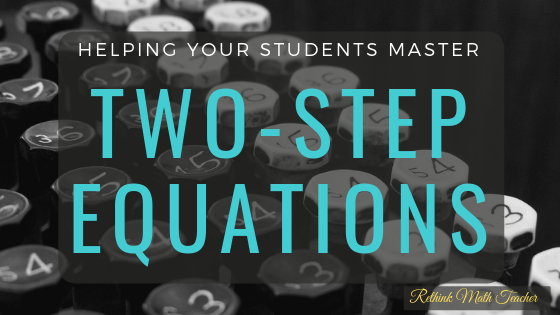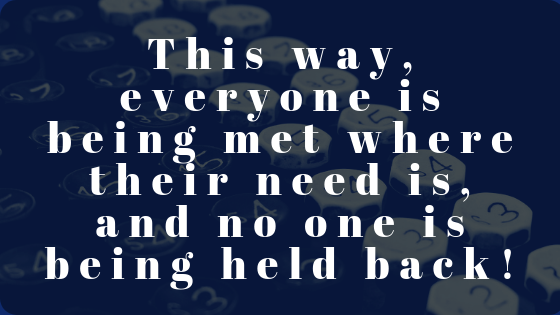
THE PROBLEM
Consider the steps involved to solve a two-step equation.

To correctly solve a two step-equations problem the student must perform a series of skills in the correct order. These skills include adding, subtracting, multiplying, and dividing integers, as well as understanding how to work a one-step equation. Sometimes, two-step equations also include the distributive property or working with fractions or decimals.
TOO OFTEN AS TEACHERS
We only teach the process portion of two-step equation problems. “What do I need to do to isolate the variable with its coefficient?” we ask. In the above problem, to do this we must get rid of the negative two. So we tell the students to add the inverse to get rid of the negative two, but make sure we do it to both sides!
UNFORTUNATELY, many of the students don’t know how to add integers, and cannot complete the above task (the first step).
Or they don’t understand how to work a one-step equation. Or they don’t remember the rules for multiplying and dividing integers
WHAT THE ISSUE IS AND ISN’T
The issue is not that your students don’t understand two-step equations (although they don’t). The issue is that they don’t understand all the prerequisite skills required to solve a two-step equation. Such as adding and subtracting integers; and so on.
WHAT WILL HELP OUR STUDENTS
Too often, when we realize our students can’t solve a two-step equation, we keep teaching them the steps in the process of solving a two-step equation. We can do this until we’re blue in the face. If our students don’t know how to do the prerequisite skills, they will never be able to solve a two-step equation.
How can they solve a two-step equation if they can’t add integers?

What our students need is for us to remediate those prerequisite skills so that they can master the grade level skill being taught (Two-Step Equations).
So if Billy can’t add or subtract integers, your time will be much better spent teaching him that, and then progressing him to two-step equations – instead of hammering two-step equations all day; which will only get him frustrated because he doesn’t understand any of the steps needed to solve. You will get frustrated too at his lack of progress.
If Jane can add, subtract, multiply and divide integers, but she doesn’t understand one-step equations, you should remediate her on that skill. Once she has demonstrated mastery, she can be progressed to two-step equations. With her newfound confidence and understanding, she is much more likely to be motivated to stay with this skill until she ‘gets-it.’ And she’s much more likely to understand two-step equations since she is now ready to be challenged at this level.

BUT HOW CAN I REACH EACH STUDENT WHEN THEY’RE ALL IN DIFFERENT PLACES
Johnny may need to work on adding integers, subtracting integers, multiplying and dividing integers, and one-step equations before he is ready to work on two-step equations.
Yet Tiffany may already know how to add and subtract integers, and she understand one-step equations, she just hasn’t mastered the rules for multiplying and dividing integers.
While Andres has mastered all of the integers skills and only needs work on one-step equations.
You see the problem. Everyone needs to work on a different prerequisite skill, at the same time. How can I reach each student, without wasting everyone’s time?
THE ANSWER IS…
Differentiation. This does not mean everyone is working on a different worksheet of the same skill. This type of differentiation has every student working on a different skill at the same time – the skill that they need to work on.
So Johnny can work on mastering adding integers, while Tiffany learns how to multiply and divide integers, and Andres practices one-step equations. All at the same time!
This way, everyone is being met where they need, and no one is being held back!

BUT HOW?
How can the teacher teach every student a different skill at the same time?
Instead of trying to teach every skill at the same time, I develop different learning stations for each skill. And inside that station are all the resources needed to master the skill. Specifically, a tutorial and lots of practice problems with immediate feedback.
WHAT’S NEXT?
To learn more about Skills-Based Learning Stations, read this article.
For resources on how to build your own Learning Stations, click here.
Click below to preview Pre-Made Learning Stations on each skill
- Adding Integers
- Subtracting Integers
- Multiplying and Dividing Integers
- One-Step Equations
- Two-Step Equations

